Effect of Transportation Operation on Air Quality in China Based on MODIS AOD during the Epidemic
Abstract
:1. Introduction
2. Materials and Methods
2.1. Materials
2.1.1. Research Area and Time
2.1.2. Research Data
Traffic Data
Air Quality Data
MODIS Data
2.1.3. Data Preprocessing
2.2. Methods
2.2.1. Time Series Analysis
2.2.2. Spatial Analysis
Kernel Density Analysis
Geographically Weighted Regression
3. Results Analysis
3.1. Temporal Characteristics
RHCDI and Urban Air Quality
3.2. Spatial Characteristics of Traffic Congestion Cities and Cities with Poor Air Quality
3.3. Spatial-Temporal Analysis
3.4. Quantitative Analysis Based on GWR
4. Discussion
5. Conclusions
Author Contributions
Funding
Institutional Review Board Statement
Data Availability Statement
Acknowledgments
Conflicts of Interest
References
- Abdull, N.; Yoneda, M.; Shimada, Y. Traffic characteristics and pollutant emission from road transport in urban area. Air Qual. Atmos. Health 2020, 13, 731–738. [Google Scholar] [CrossRef]
- Oishi, R.; Imai, Y.; Ikemori, F.; Ohura, T. Traffic source impacts on chlorinated polycyclic aromatic hydrocarbons in PM2.5 by short-range transport. Atmos. Environ. 2019, 216, 116944. [Google Scholar] [CrossRef]
- Lv, C. Research on High Resolution Transport Carbon Emission Inventory and Analysis of Low Carbon Development Scenario in Beijing; Beijing University of Technology: Beijing, China, 2020. [Google Scholar]
- Wang, Q.; Feng, H.X.; Feng, H.Y.; Yu, Y.; Li, J.; Ning, E.W. The impacts of road traffic on urban air quality in Jinan based GWR and remote sensing. Sci. Rep. 2021, 11, 15512. [Google Scholar] [CrossRef] [PubMed]
- Lima, M.A.; Sthel, M.S. Emission of air pollution in the transport sector: Case study of the city of campos dos goytacazes, Brazil. Engineering 2020, 12, 851–862. [Google Scholar] [CrossRef]
- Li, Z.; Fung, J.C.H.; Lau, A.K.H. High spatiotemporal characterization of on-road PM 2.5 concentrations in high-density urban areas using mobile monitoring. Build. Environ. 2018, 143, 196–205. [Google Scholar] [CrossRef]
- Pathak, A.K.; Sharma, M.; Nagar, P.K. A framework for PM2.5 constituents-based (including PAHs) emission inventory and source toxicity for priority controls: A case study of Delhi, India. Chemosphere 2020, 255, 126971. [Google Scholar] [CrossRef]
- Jeong, C.H.; Wang, J.M.; Hilker, N.; Debosz, J.; Sofowote, U.; Su, Y.; Noble, M.; Healy, R.M.; Munoz, T.; Dabek-Zlotorzynska, E.; et al. Temporal and spatial variability of traffic-related PM(2.5) sources: Comparison of exhaust and non-exhaust emissions. Atmos. Environ. 2019, 198, 55–69. [Google Scholar] [CrossRef]
- Monteiro, A.; Durka, P.; Flandorfer, C.; Georgieva, E.; Guerreiro, C.; Kushta, J.; Malherbe, L.; Maiheu, B.; Miranda, A.I.; Stocker, J.; et al. Strengths and weaknesses of the FAIRMODE benchmarking methodology for the evaluation of air quality models. Air Qual. Atmos. Health 2018, 11, 373–383. [Google Scholar] [CrossRef]
- Ramacher, M.; Matthias, V.; Aulinger, A.; Quante, M.; Bieser, J.; Karl, M. Contributions of traffic and shipping emissions to city-scale NOx and PM2.5 exposure in Hamburg. Atmos. Environ. 2020, 237, 117674. [Google Scholar] [CrossRef]
- Mangones, S.C.; Jaramillo, P.; Rojas, N.Y.; Fischbeck, P. Air pollution emission effects of changes in transport supply: The case of Bogotá, Colombia. Environ. Sci. Pollut. Res. 2020, 27, 35971–35978. [Google Scholar] [CrossRef]
- Russo, F.; Villani, M.G.; D’Elia, H.; D’Isidoro, M.; Liberto, C.; Piersanti, A.; Tinarelli, G.; Valenti, G.; Ciancarella, L. A study of traffic emissions based on floating car data for urban scale air quality applications. Atmosphere 2021, 12, 1064. [Google Scholar] [CrossRef]
- Altintasi, O.; Tuydes-Yaman, H.; Tuncay, K. Monitoring urban traffic from floating car data (FCD): Using speed or a los-based state measure. In Scientific and Technical Conference Transport Systems Theory and Practice; Springer: Cham, Switzerland, 2018; pp. 163–173. [Google Scholar] [CrossRef]
- Cárdenas-Benítez, N.; Aquino-Santos, R.; Magaña-Espinoza, P.; Aguilar-Velazco, J.; Edwards-Block, A.; Cass, A.M. Traffic congestion detection system through connected vehicles and big data. Sensors 2016, 16, 599–625. [Google Scholar] [CrossRef]
- Chen, F.X.; Yin, Z.W.; Ye, Y.W.; Sun, D. Taxi hailing choice behavior and economic benefit analysis of emission reduction based on multi-mode travel big data. Transp. Policy 2020, 97, 73–84. [Google Scholar] [CrossRef]
- Qin, Y.N.; Yang, H.L.; Guo, M.J.; Guo, M.C. An Advanced data science model based on big data analytics for urban driving cycle construction in China. In Proceedings of the 2020 International Conference on Computing, Networks and Internet of Things, Sanya, China, 24–26 April 2020; pp. 1–7. [Google Scholar] [CrossRef]
- Hu, Y.H.; Yan, Q.Y. Response to Carbon emission flow from self-driving tours and its spatial relationship with scenic spots—A traffic-related big data method. J. Clean. Prod. 2019, 247, 119540. [Google Scholar] [CrossRef]
- Wang, L.; Chen, C.; Xie, F.; Hu, Z.; Zhang, Z.; Chen, H.; He, X.; Chu, Y. Estimation of the value of regional ecosystem services of an archipelago using satellite remote sensing technology: A case study of Zhoushan Archipelago, China. Int. J. Appl. Earth Obs. Geoinf. 2021, 105, 102616. [Google Scholar] [CrossRef]
- Chen, C.; Liang, J.; Xie, F.; Hu, Z.; Sun, W.; Yang, G.; Yu, J.; Chen, L.; Wang, L.H.; Wang, L.Y.; et al. Temporal and spatial variation of coastline using remote sensing images for Zhoushan archipelago, China. Int. J. Appl. Earth Obs. Geoinf. 2022, 107, 102711. [Google Scholar] [CrossRef]
- Chen, L.F.; Tao, J.H.; Wang, Z.F.; Li, S.S.; Zhang, Y.; Fan, M.; Li, X.Y.; Yu, C.; Zou, M.M.; Su, L.; et al. Review of Satellite Remote Sensing of Air Quality. J. Atmos. Environ. Opt. 2015, 10, 117. [Google Scholar] [CrossRef]
- Tao, J.H.; Zhang, M.G.; Chen, L.F.; Wang, Z.F.; Su, L.; Ge, C.; Han, X.; Zou, M.M. Method to estimate concentration of surface-level particulate matter from satellite-based aerosol optical thickness. Sci. China: Earth Sci. 2013, 56, 1422–1433. [Google Scholar] [CrossRef]
- Wei, J.; Li, Z.Q.; Lyapustin, A. Reconstructing 1-km-resolution high-quality PM 2.5 data records from 2000 to 2018 in China: Spatiotemporal variations and policy implications. Remote Sens. Environ. 2021, 252, 112136. [Google Scholar] [CrossRef]
- Sathe, Y.; Kulkarni, S.; Gupta, P.; Kaginalkar, A.; Islam, S.; Gargava, P. Resolution Imaging Spectroradiometer (MODIS) Aerosol Optical Depth (AOD) and Weather Research Forecasting (WRF) model meteorological data for assessment of fine particulate matter (PM2.5) over India—ScienceDirect. Atmos. Pollut. Res. 2019, 10, 418–434. [Google Scholar] [CrossRef]
- Aletta, F.; Brinchi, S.; Carrese, S.; Gemma, A.; Guattari, C.; Mannini, L.; Patella, M. Analysing urban traffic volumes and mapping noise emissions in Rome (Italy) in the context of containment measures for the COVID-19 disease. Noise Mapp. 2020, 7, 114–122. [Google Scholar] [CrossRef]
- Wang, J.B.; Yang, X.S.; Yu, S.C.; Yuan, Q.; Lian, Z.T.; Yang, Q.L. Road crash risk prediction during COVID-19 for flash crowd traffic prevention: The case of Los Angeles. Comput. Commun. 2023, 198, 195–205. [Google Scholar] [CrossRef] [PubMed]
- Lee, H.; Park, S.J.; Lee, G.R.; Kim, J.E.; Lee, J.H.; Jung, Y.; Nam, E.W. The relationship between trends in COVID-19 prevalence and traffic levels in South Korea. Int. J. Infect. Dis. 2020, 96, 399–407. [Google Scholar] [CrossRef] [PubMed]
- Le, T.; Wang, Y.; Liu, L.; Yang, J.; Yung, Y.L.; Li, G.H.; Seinfeld, J.H. Unexpected air pollution with marked emission reductions during the COVID-19 outbreak in China. Science 2020, 369, eabb7431. [Google Scholar] [CrossRef] [PubMed]
- Tian, H.; Liu, Y.; Li, Y.; Wu, C.H.; Chen, B.; Kraemer, M.G.; Li, B.Y.; Cai, J.; Xu, B.; Yang, Q. An investigation of transmission control measures during the first 50 days of the COVID-19 epidemic in China. Science 2020, 368, 638–642. [Google Scholar] [CrossRef] [Green Version]
- Shi, X.; Brasseur, G.P. The Response in Air Quality to the Reduction of Chinese Economic Activities during the COVID Outbreak. Geophys. Res. Lett. 2020, 47, e2020GL088070. [Google Scholar] [CrossRef] [PubMed]
- Wang, P.; Chen, K.; Zhu, S.; Wang, P.; Zhang, H.L. Severe air pollution events not avoided by reduced anthropogenic activities during COVID-19 outbreak. Resour. Conserv. Recycl. 2020, 158, 104814. [Google Scholar] [CrossRef]
- Yan, X.; Shi, A.; Cao, J.; Li, T.T.; Sun, X.S.; Zhang, R.; Qiu, X.H.; Li, Y.X.; Liang, M.; Lv, M.; et al. The Occurrence of Heavy Air Pollution during the COVID-19 Outbreak in Beijing, China: Roles of Emission Reduction, Meteorological Conditions, and Regional Transport. Sustainability 2021, 13, 12312. [Google Scholar] [CrossRef]
- Tyagi, B.; Choudhury, G.; Vissa, N.K.; Singh, J.; Tesche, M. Changing Air Pollution Scenario During COVID-19: Redefining the Hotspot Regions over India. Environ. Pollut. 2020, 271, 116354. [Google Scholar] [CrossRef]
- Singh, V.; Singh, S.; Biswal, A.; Kesarkar, A.P.; Mor, S.; Ravindra, K. Diurnal and temporal changes in air pollution during COVID-19 strict lockdown over different regions of India. Environ. Pollut. 2020, 266, 115368. [Google Scholar] [CrossRef]
- Zalakeviciute, R.; Vasquez, R.; Bayas, D.; Buenano, A.; Mejia, D.; Zegarra, R.; Diaz, V.; Lamb, B. Drastic Improvements in Air Quality in Ecuador during the COVID-19 Outbreak. Aerosol Air Qual. Res. 2020, 20, 1783–1792. [Google Scholar] [CrossRef]
- Lorenzo-Sáez, E.; Coll-Aliaga, E.; Oliver-Villanueva, J.V.; Campo, F.P.F.; Lerma-Arce, V. Analysis of the COVID-19 Lockdown’s Impact on Air Quality in the Larger Cities of Spain. Sustainability 2022, 14, 5613. [Google Scholar] [CrossRef]
- Mashayekhi, R.; Pavlovic, R.; Racine, J.; Moran, M.D.; Mashayekhi, R.; Pavlovic, R.; Racine, J.; Manseau, A.D.; Katal, A.; Miville, I. Isolating the impact of COVID-19 lockdown measures on urban air quality in Canada. Air Qual. Atmos. Health 2021, 14, 1549–1570. [Google Scholar] [CrossRef] [PubMed]
- Ginzburg, A.S.; Semenov, V.A.; Semutnikova, E.G.; Aleshina, M.A.; Zakharova, P.V.; Lezina, E.A. Impact of COVID-19 Lockdown on Air Quality in Moscow. Doklady Earth Sci. 2020, 495, 862–866. [Google Scholar] [CrossRef]
- Kenawy, A.; Juan, I.L.; Mccabe, M.F.; Domínguez-Castro, F.; Peña-Angulo, D.; Gaber, I.M.; Alqasemi, A.S.; Kindi, K.M.A.; Al-Awadhi, T.; Hereher, M.E.; et al. The impact of COVID-19 lockdowns on surface urban heat island changes and air-quality improvements across 21 major cities in the Middle East. Environ. Pollut. 2021, 288, 117802. [Google Scholar] [CrossRef]
- Bauwens, M.; Compernolle, S.; Stavrakou, T.; Müller, J.-F.; Gent, J.V.; Eskes, H.; Levelt, P.F.; Van der A, R.; Veefkind, J.P.; Vlietinck, J.; et al. Impact of coronavirus outbreak on NO2 pollution assessed using TROPOMI and OMI observations. Geophys. Res. Lett. 2020, 47, e2020GL087978. [Google Scholar] [CrossRef] [PubMed]
- Kaloni, D.; Lee, Y.H.; Dev, S. Impact of COVID19-induced Lockdown on Air Quality in Ireland. In Proceedings of the 2021 IEEE International Geoscience and Remote Sensing Symposium IGARSS, Brussels, Belgium, 11–16 July 2021; pp. 8372–8375. [Google Scholar] [CrossRef]
- Nichol, J.E.; Bilal, M.; Ali, A.M.; Qiu, Z.F. Air Pollution Scenario over China during COVID-19. Remote Sens. 2020, 12, 2100. [Google Scholar] [CrossRef]
- Chen, Z.F.; Hao, X.Y.; Zhang, X.Y.; Chen, F.L. Have traffic restrictions improved air quality? A shock from COVID-19. J. Clean. Prod. 2021, 279, 123622. [Google Scholar] [CrossRef] [PubMed]
- Wu, C.L.; Wang, H.W.; Cai, W.J.; He, H.D.; Ni, A.N.; Peng, Z.R. Impact of the COVID-19 lockdown on roadside traffic-related air pollution in Shanghai, China. Build. Environ. 2021, 194, 107718. [Google Scholar] [CrossRef]
- Gao, C.C..; Li, S.H..; Liu, M.; Zhang, F.Y.; Achal, V.; Tu, Y.; Zhang, S.Q.; Cai, C.L. Impact of the COVID-19 pandemic on air pollution in Chinese megacities from the perspective of traffic volume and meteorological factors. Sci. Total Environ. 2021, 773, 145545. [Google Scholar] [CrossRef]
- Jia, C.Y.; Li, W.D.; Wu, T.C.; He, M. Road traffic and air pollution: Evidence from a nationwide traffic control during coronavirus disease 2019 outbreak. Sci. Total Environ. 2021, 781, 146618. [Google Scholar] [CrossRef] [PubMed]
- Lipsitt, J.; Chan-Golston, A.M.; Liu, J.; Su, J.; Zhu, Y.F.; Jerrett, M. Spatial analysis of COVID-19 and traffic-related Air Pollution in Los Angeles. Environ. Int. 2021, 153, 106531. [Google Scholar] [CrossRef]
- Ghiasi, B.; Alisoltani, T.; Jalali, F.; Tahsinpour, H. Effect of COVID-19 on transportation air pollution by moderation and mediation analysis in Queens, New York. Air Quality Atmos. Health 2022, 15, 289–297. [Google Scholar] [CrossRef]
- Ahin, L.A. The Effects of COVID-19 Measures on Air Pollutant Concentrations at Urban and Traffic Sites in Istanbul. Aerosol Air Qual. Res. 2020, 20, 1874–1885. [Google Scholar] [CrossRef]
- Górka-Kostrubiec, B.; Dudzisz, K. Effect of COVID-19 pandemic restrictions on air pollution at a local scale in urban areas affected by high-intensity vehicle traffic in Poland. Atmos. Space Sci. 2022, 71, 1085–1097. [Google Scholar] [CrossRef]
- Xiang, J.B.; Austin, E.; Gould, T. Impacts of the COVID-19 responses on traffic-related air pollution in a Northwestern US city. Science 2020, 747, 141325. [Google Scholar] [CrossRef]
- Rossi, R.; Ceccato, R.; Gastaldi, M. Effect of Road Traffic on Air Pollution. Experimental Evidence from COVID-19 Lockdown. Sustainability 2020, 12, 8984. [Google Scholar] [CrossRef]
- Lyapustin, A.; Wang, Y.; Laszlo, I.; Kahn, R.; Korkin, S.; Remer, L.; Levy, R.; Reid, J.S. Multiangle implementation of atmospheric correction (MAIAC): 2. Aerosol algorithm. J. Geophys. Res. Atmos. 2011, 116, 14986. [Google Scholar] [CrossRef]
- Chen, Z.Y.; Jin, J.Q.; Zhang, R.; Zhang, T.H.; Chen, J.J.; Yang, J.; Ou, C.Q.; Guo, Y.M. Comparison of different missing-imputation methods for MAIAC (Multiangle Implementation of Atmospheric Correction) AOD in estimating daily PM2.5 Levels. Remote Sens. 2020, 12, 3008. [Google Scholar] [CrossRef]
- Wang, Z.B.; Zou, B.; Qiu, Y.H.; Chen, J.W. Geographical characterization of relationship between aerosol optical depth and PM(2.5) in China. Remote Sens. Inf. 2016, 31, 26–35. [Google Scholar]
- Wei, H.N.; Liang, B.P.; Zhong, S. Analysis of Temporal and Spatial Distribution and Variation Characteristics of Aerosol in Guilin Based on the MODIS Data. Adm. Tech. Environ. Monit. 2018, 30, 16–21. [Google Scholar]
- Chen, H.; Chen, C.; Zhang, Z.; Lu, C.; Wang, L.Y.; He, X.Y.; Chu, Y.L.; Chen, J.Y. Changes of the spatial and temporal characteristics of land-use landscape patterns using multi-temporal Landsat satellite data: A case study of Zhoushan Island, China. Ocean. Coast. Manag. 2021, 213, 105842. [Google Scholar] [CrossRef]
- Wang, P.; Tang, Q.X.; Zhu, Y.X.; Zheng, K.; Liang, T.Q.; Yu, Q.Z.; He, Y.Q. Validation and Analysis of MAIAC AOD Aerosol Products in East Asia from 2011 to 2020. Remote. Sens. 2022, 14, 5735. [Google Scholar] [CrossRef]
- Liu, J.; Ding, J.L.; Li, L.; Li, X.H.; Zhang, Z.; Ran, S.; Ge, X.Y.; Zhang, J.Y.; Wang, J.Z. Characteristics of aerosol optical depth over land types in central Asia. Sci. Total Environ. 2020, 727, 138676. [Google Scholar] [CrossRef]
- Emili, E.; Popp, C.; Petitta, M.; Riffler, M.; Wunderle, S.; Zebisch, M. PM10 remote sensing from geostationary SEVIRI and polar-orbiting MODIS sensors over the complex terrain of the European Alpine region. Remote Sens. Environ. 2010, 114, 2485–2499. [Google Scholar] [CrossRef]
- Chen, C.; Chen, H.; Liang, J.; Huang, W.; Xu, W.; Li, B.; Wang, J. Extraction of water body information from remote sensing imagery while considering greenness and wetness based on Tasseled Cap transformation. Remote Sens. 2022, 14, 3001. [Google Scholar] [CrossRef]
- Zou, Z.; Chen, C.; Liu, Z.; Zhang, Z.; Liang, J.; Chen, H.; Wang, L. Extraction of Aquaculture Ponds along Coastal Region Using U2-Net Deep Learning Model from Remote Sensing Images. Remote Sens. 2022, 14, 4001. [Google Scholar] [CrossRef]

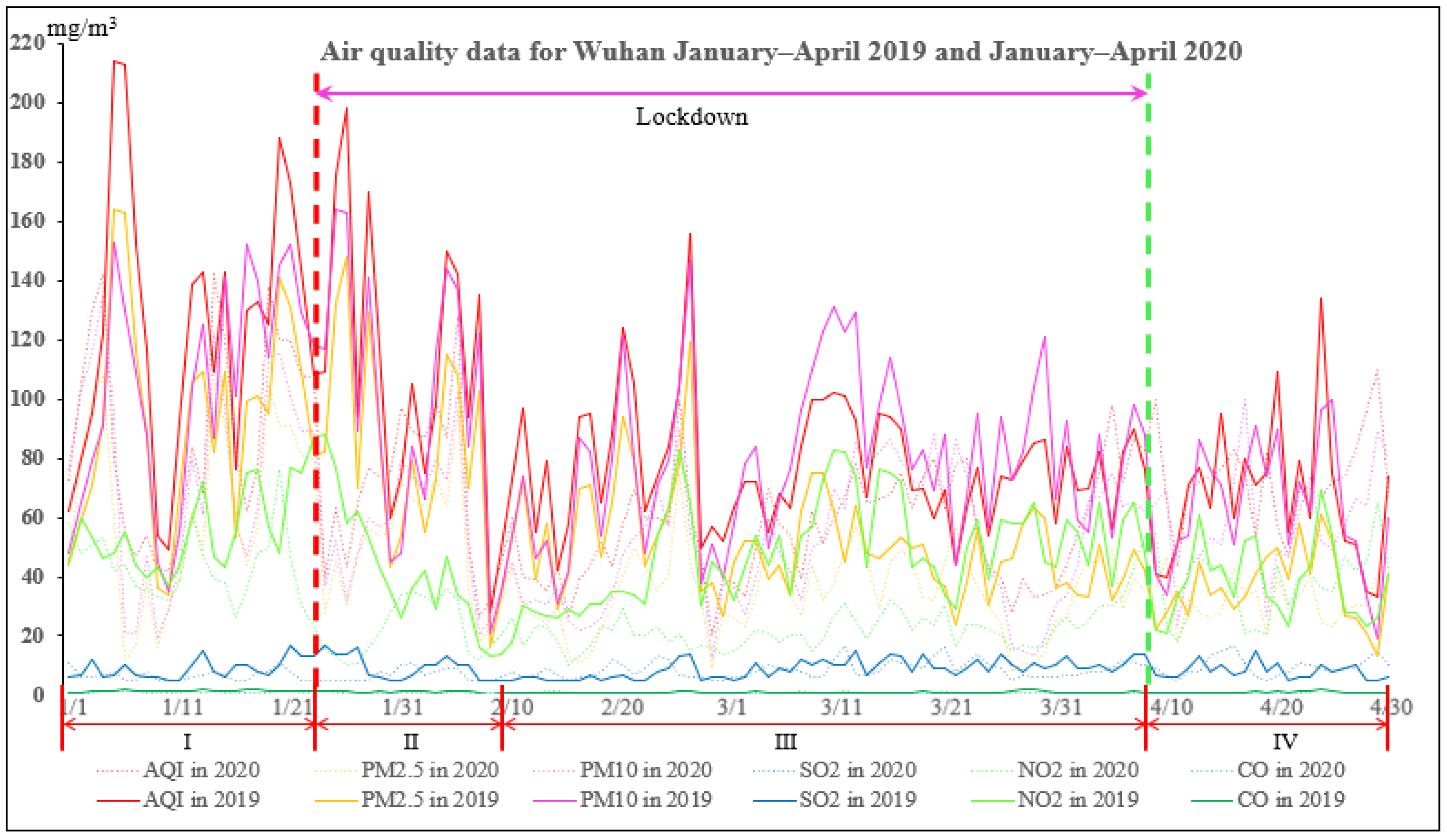
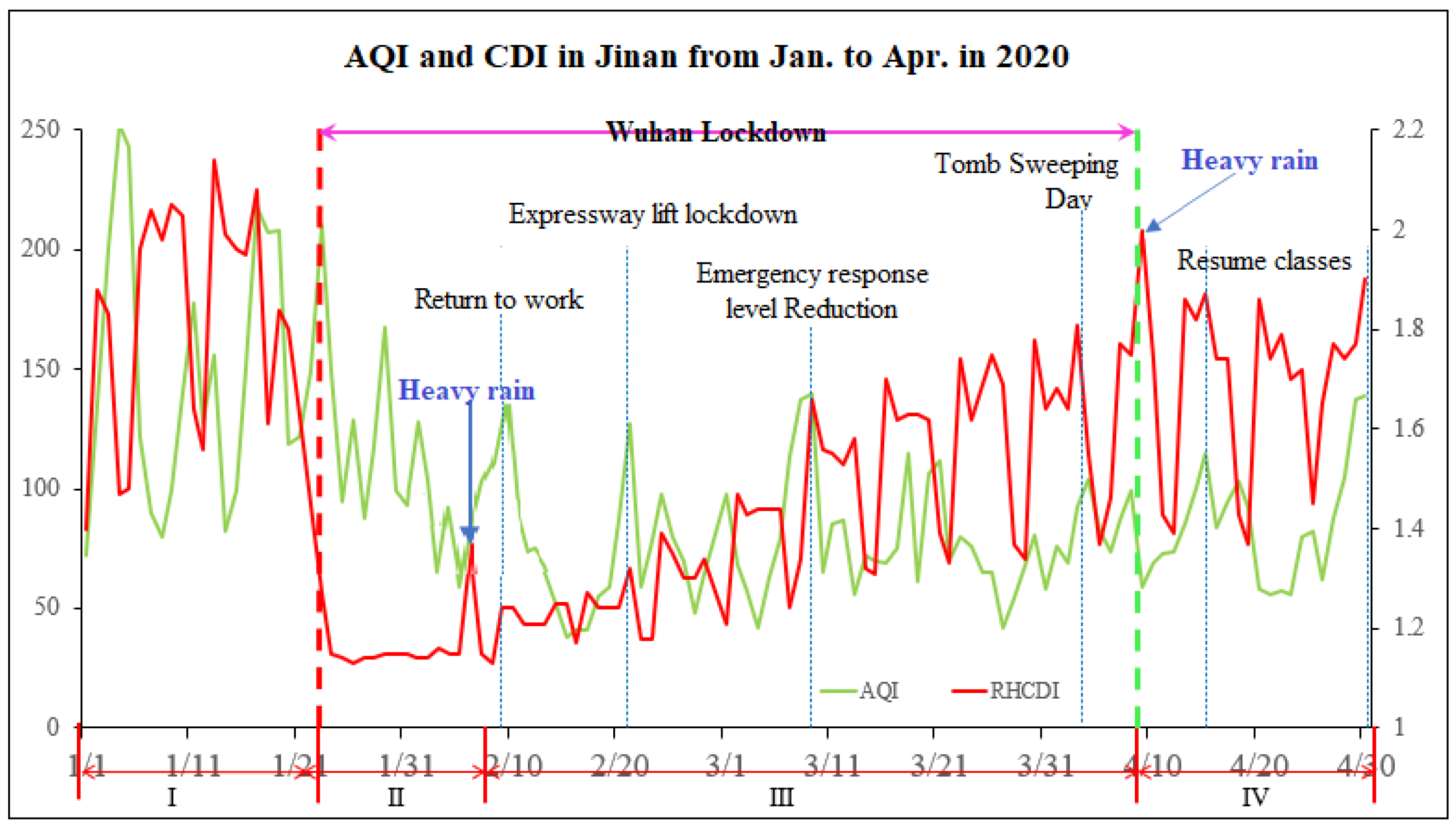
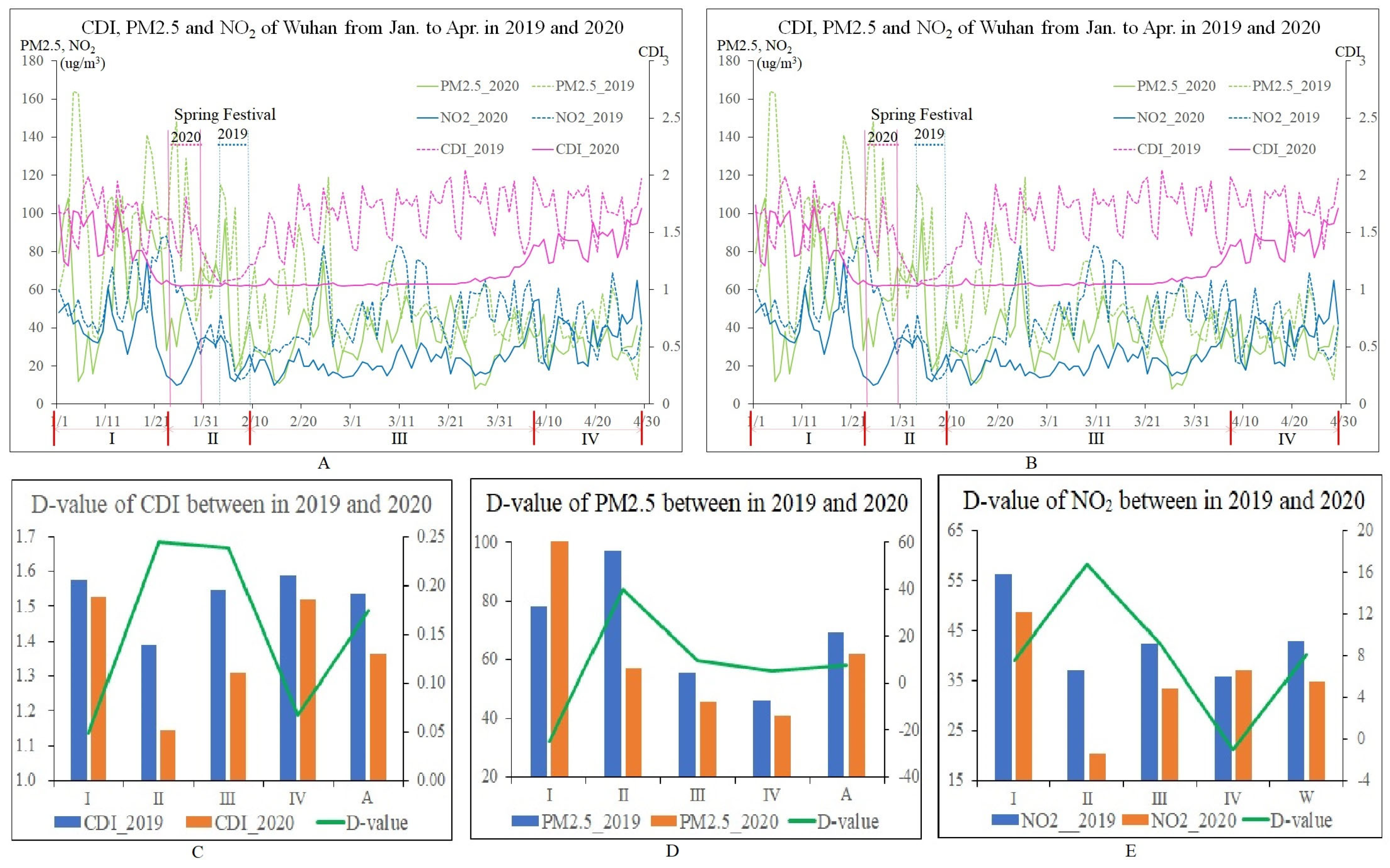
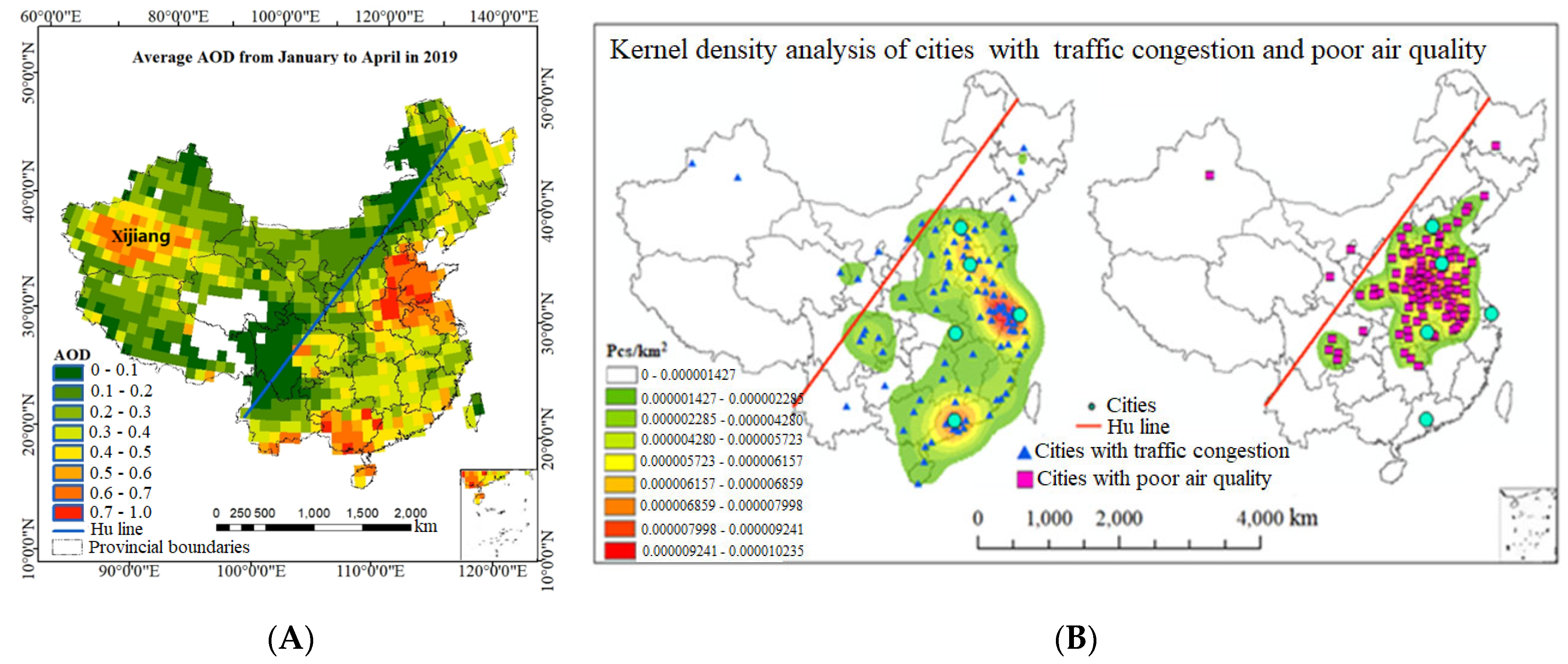
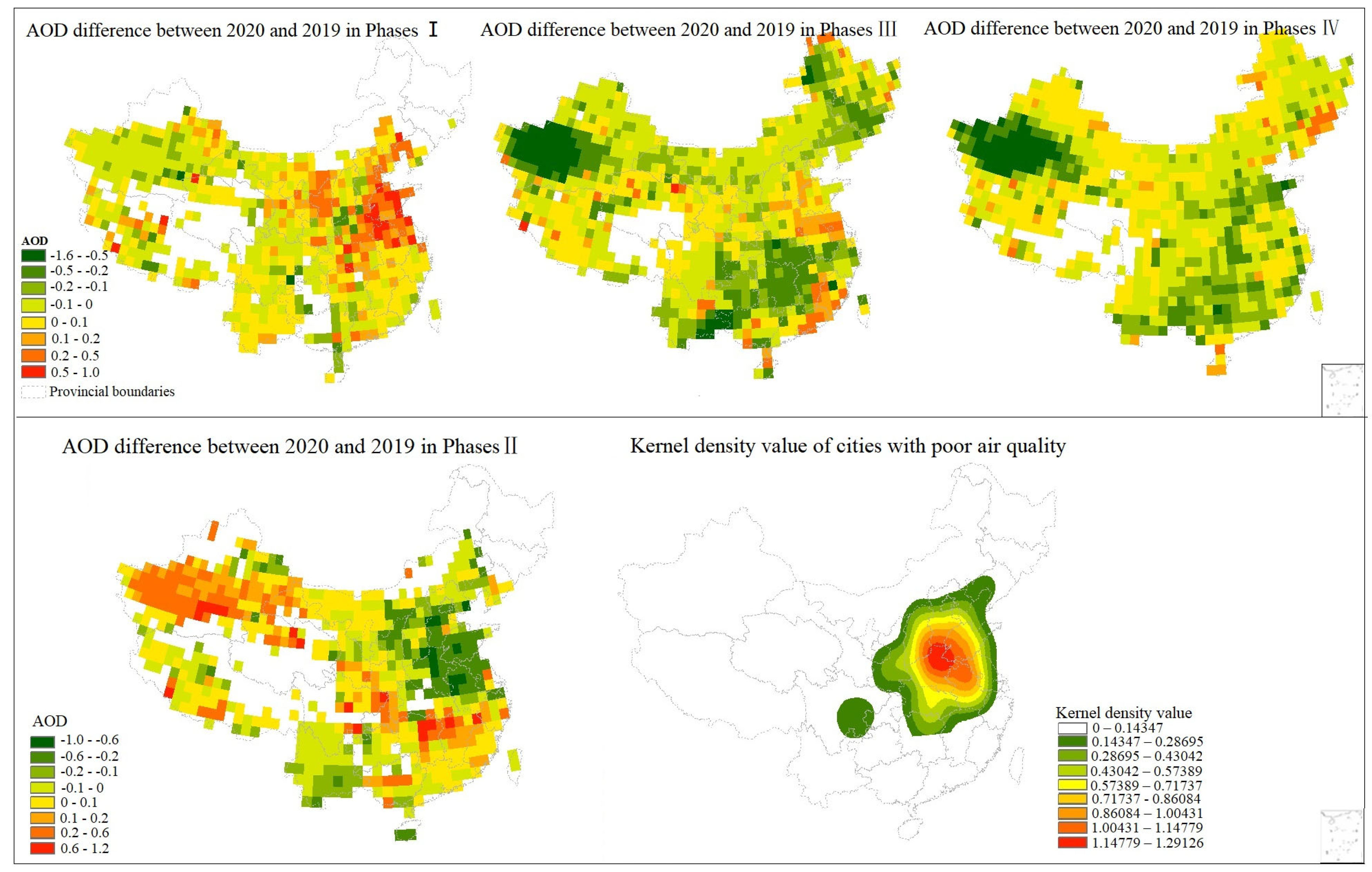
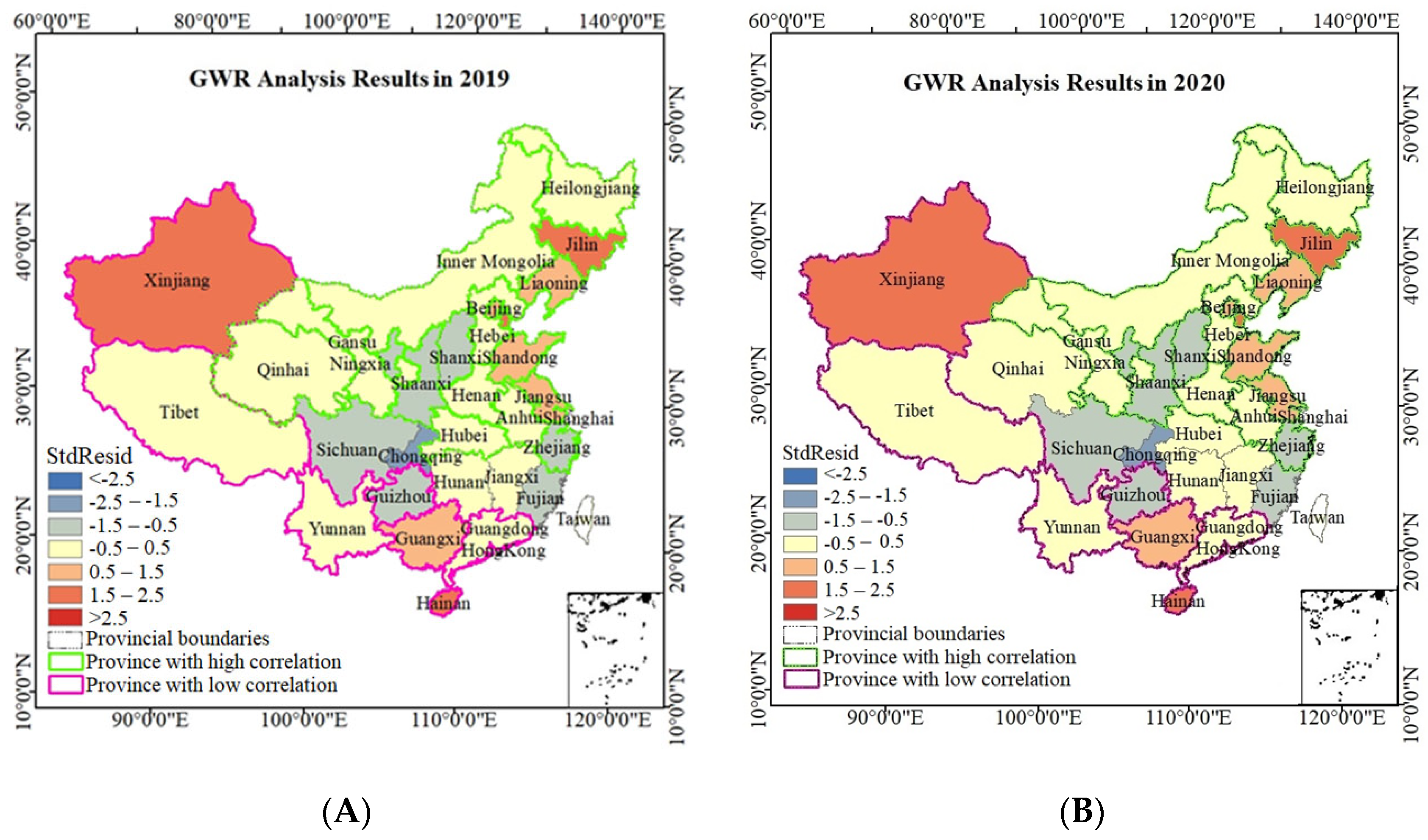
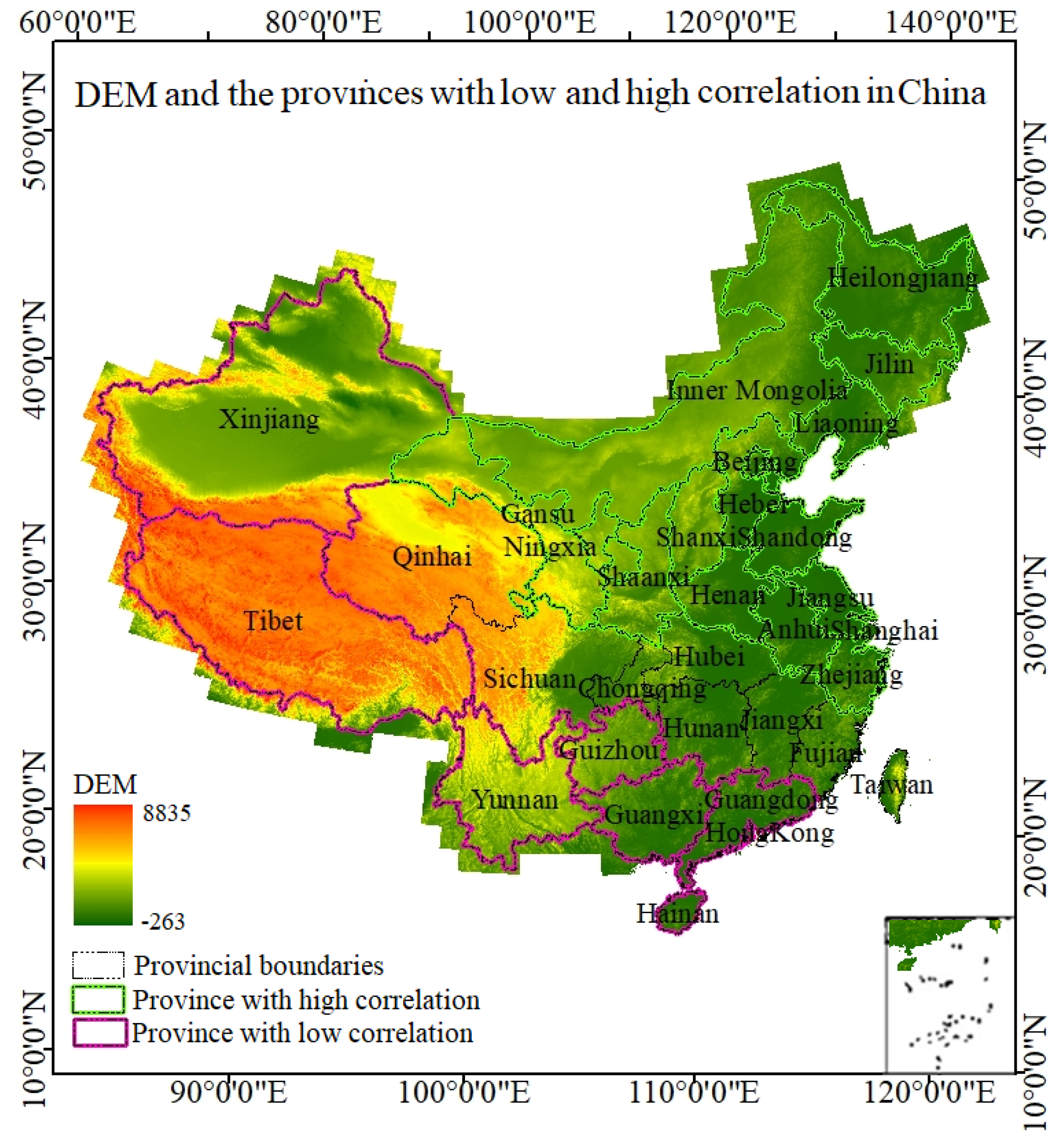
| Time | Phase | Remarks |
|---|---|---|
| 1 January–22 January | I | the early period of the epidemic, only Wuhan city was affected |
| 23 January–9 February | II | Wuhan was in lockdown, the country was kept in quarantine |
| 10 February–7 April | III | resume work |
| 8 April–30 April | IV | Wuhan was unlocked |
Disclaimer/Publisher’s Note: The statements, opinions and data contained in all publications are solely those of the individual author(s) and contributor(s) and not of MDPI and/or the editor(s). MDPI and/or the editor(s) disclaim responsibility for any injury to people or property resulting from any ideas, methods, instructions or products referred to in the content. |
© 2023 by the authors. Licensee MDPI, Basel, Switzerland. This article is an open access article distributed under the terms and conditions of the Creative Commons Attribution (CC BY) license (https://creativecommons.org/licenses/by/4.0/).
Share and Cite
Feng, H.; Wu, Z.; Li, X.; Xian, H.; Jia, Q.; Wang, X.; Zhu, M. Effect of Transportation Operation on Air Quality in China Based on MODIS AOD during the Epidemic. Sustainability 2023, 15, 4064. https://doi.org/10.3390/su15054064
Feng H, Wu Z, Li X, Xian H, Jia Q, Wang X, Zhu M. Effect of Transportation Operation on Air Quality in China Based on MODIS AOD during the Epidemic. Sustainability. 2023; 15(5):4064. https://doi.org/10.3390/su15054064
Chicago/Turabian StyleFeng, Haixia, Zhouhao Wu, Xin Li, Huacai Xian, Qiang Jia, Xingyu Wang, and Maoxin Zhu. 2023. "Effect of Transportation Operation on Air Quality in China Based on MODIS AOD during the Epidemic" Sustainability 15, no. 5: 4064. https://doi.org/10.3390/su15054064






